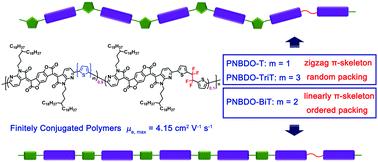Remarkable effect of π-skeleton conformation in finitely conjugated polymer semiconductors†
Abstract
The structure–property relationship of finitely conjugated polymer semiconductors is underdeveloped to date. Herein, we report three novel tetrafluoroethylene-containing finitely conjugated polymers, PNBDO-T, PNBDO-BiT and PNBDO-TriT, containing electron-donating units of thiophene (T), 2,2′-bithiophene (BiT), or 2,2′:5′,2′′-terthiophene (TriT), respectively. All three polymers showed ambipolar charge transport characteristics under ambient conditions. PNBDO-BiT with a centrosymmetric BiT unit exhibited a maximum electron mobility of 4.15 cm2 V−1 s−1, much higher than the mobilities of 1.01 × 10−2 and 0.052 cm2 V−1 s−1 of PNBDO-T and PNBDO-TriT, respectively, with axisymmetric T or TriT units. Meanwhile, PNBDO-BiT formed more ordered and crystalline molecular aggregation than the other two polymers. We attributed the differences to their π-skeleton conformations induced by the centrosymmetric or axisymmetric electron-donating units in these polymers. The results show that the construction of linear π-skeletons is of great importance in the development of high-performance finitely conjugated polymer semiconductors.



 Please wait while we load your content...
Please wait while we load your content...